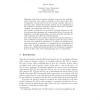Free Online Productivity Tools
i2Speak
i2Symbol
i2OCR
iTex2Img
iWeb2Print
iWeb2Shot
i2Type
iPdf2Split
iPdf2Merge
i2Bopomofo
i2Arabic
i2Style
i2Image
i2PDF
iLatex2Rtf
Sci2ools
110
Voted
DAGSTUHL
1996
1996
Pragmatics of Type-Directed Partial Evaluation
Abstract. Type-directed partial evaluation stems from the residualization of arbitrary static values in dynamic contexts, given their type. Its algorithm coincides with the one for coercing a subtype value into a supertype value, which itself coincides with the one of normalization in the -calculus. Type-directed partial evaluation is thus used to specialize compiled, closed programs, given their type. Since Similix, let-insertion is a cornerstone of partial evaluators for callby-value procedural programs with computational e ects. It prevents the duplication of residual computations, and more generally maintains the order of dynamic side e ects in residual programs. This article describes the extension of type-directed partial evaluation to insert residual let expressions. This extension requires the user to annotate arrow types with e ect information. It is achieved by delimiting and ing control, comparably to continuation-based specialization in direct style. It enables type-directe...
Arbitrary Static Values | DAGSTUHL 1996 | DAGSTUHL 2007 | Residual Programs | Type-directed Partial Evaluation |
Related Content
| Added | 02 Nov 2010 |
| Updated | 02 Nov 2010 |
| Type | Conference |
| Year | 1996 |
| Where | DAGSTUHL |
| Authors | Olivier Danvy |
Comments (0)

